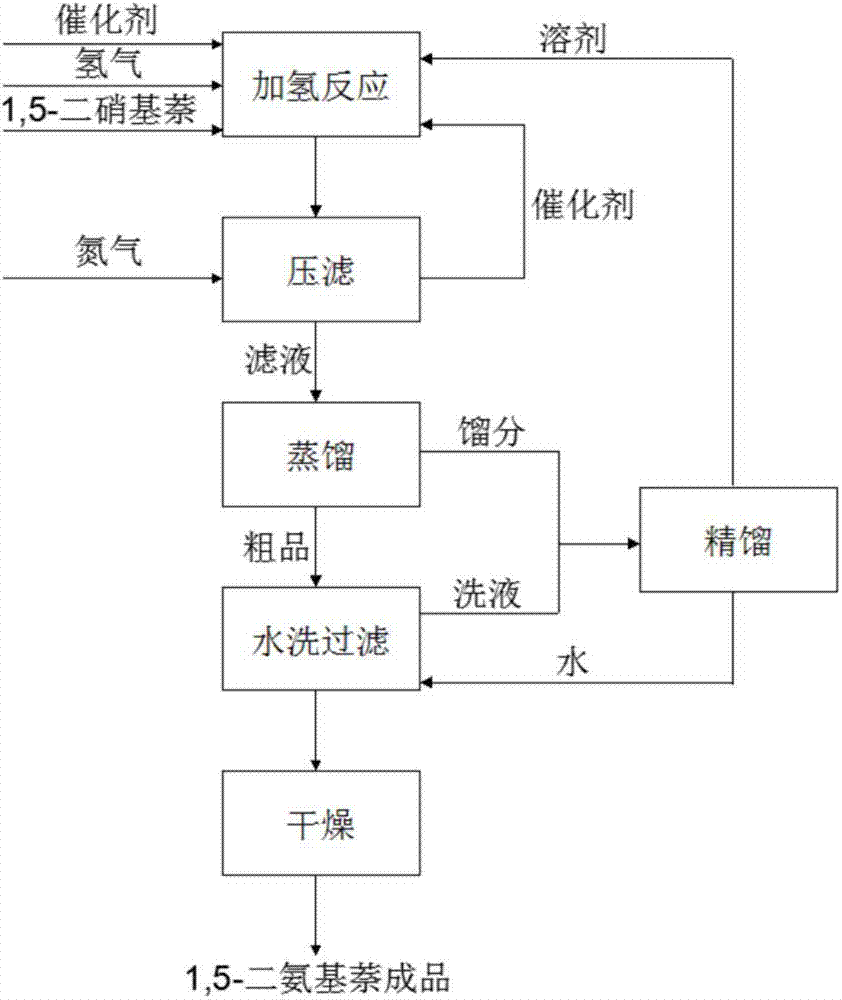Environment-friendly 1, 5-diamido-naphthlamine production technique
A diaminonaphthalene, environment-friendly technology, applied in the field of 1,5-diaminonaphthalene production process, to achieve the effects of simple and efficient recovery, high reaction yield, and simplified reaction and separation process
- Summary
- Abstract
- Description
- Claims
- Application Information
AI Technical Summary
Problems solved by technology
Method used
Image
Examples
Embodiment 1
[0024] Put 20g of raw material 1,5-dinitronaphthalene, 50g of solvent DMF, and 0.1g of Pd / C catalyst with a loading mass content of 5% into a 100mL autoclave. Replace with hydrogen for 3 to 5 times, then fill with 0.4MPa hydrogen, maintain the reaction temperature at 50°C for 5 hours, replace the hydrogen in the kettle with nitrogen, and recover the Pd / C catalyst in the reaction solution by nitrogen pressure filtration. The filtrate was distilled under reduced pressure to obtain crude 1,5-diaminonaphthalene, which was washed and filtered with 50 g of water, and then dried to obtain 1,5-diaminonaphthalene. The product was analyzed by liquid chromatography, and its content was 96.8%. Calculate the product The yield was 92.7%. DMF and water are recovered by vacuum rectification after mixing the distilled fraction and the washing liquid after washing with water for the next batch of reactions.
Embodiment 2
[0026] Put 20g of raw material 1,5-dinitronaphthalene, 50g of solvent DMF, and 0.06g of Pd / C catalyst with a load mass content of 5% into a 100mL autoclave. Replace with hydrogen 3 to 5 times, then fill with 0.5MPa hydrogen, maintain the reaction temperature at 40°C for 7 hours, replace the hydrogen in the kettle with nitrogen, and recover the Pd / C catalyst in the reaction solution by nitrogen pressure filtration. The filtrate was distilled under reduced pressure to obtain the crude product of 1,5-diaminonaphthalene. The crude product was washed and filtered with 50 g of water, and then dried to obtain 1,5-diaminonaphthalene. The product was analyzed by liquid chromatography, and its content was 97.5%. Calculate the product The yield was 92.7%. DMF and water are recovered by vacuum rectification after mixing the distilled fraction and the washing liquid after washing with water for the next batch of reactions.
Embodiment 3
[0028] Put 200g of raw material 1,5-dinitronaphthalene, 500g of solvent DMF, and 0.6g of Pd / C catalyst with a loading mass content of 5% into a 1000mL autoclave. Replace with hydrogen for 3 to 5 times, then fill with 0.5MPa hydrogen, maintain the reaction temperature at 50°C for 7 hours, replace the hydrogen in the kettle with nitrogen, and recover the Pd / C catalyst in the reaction solution by nitrogen pressure filtration. The filtrate was distilled under reduced pressure to obtain crude 1,5-diaminonaphthalene, which was washed and filtered with 500g of water, and then dried to obtain 1,5-diaminonaphthalene. The product was analyzed by liquid chromatography, and its content was 97.7%. Calculate the product The yield was 93.1%. DMF and water are recovered by vacuum rectification after mixing the distilled fraction and the washing liquid after washing with water for the next batch of reactions.
PUM
 Login to View More
Login to View More Abstract
Description
Claims
Application Information
 Login to View More
Login to View More - R&D
- Intellectual Property
- Life Sciences
- Materials
- Tech Scout
- Unparalleled Data Quality
- Higher Quality Content
- 60% Fewer Hallucinations
Browse by: Latest US Patents, China's latest patents, Technical Efficacy Thesaurus, Application Domain, Technology Topic, Popular Technical Reports.
© 2025 PatSnap. All rights reserved.Legal|Privacy policy|Modern Slavery Act Transparency Statement|Sitemap|About US| Contact US: help@patsnap.com

